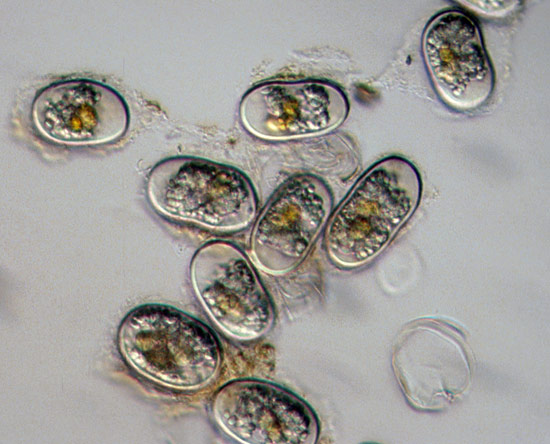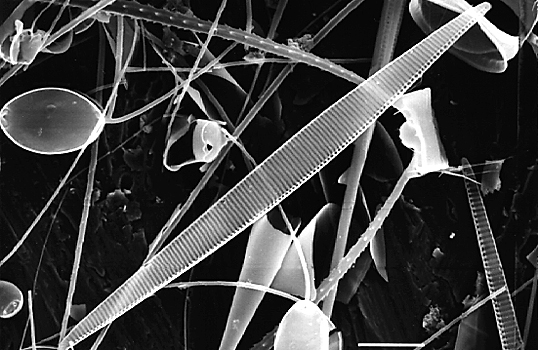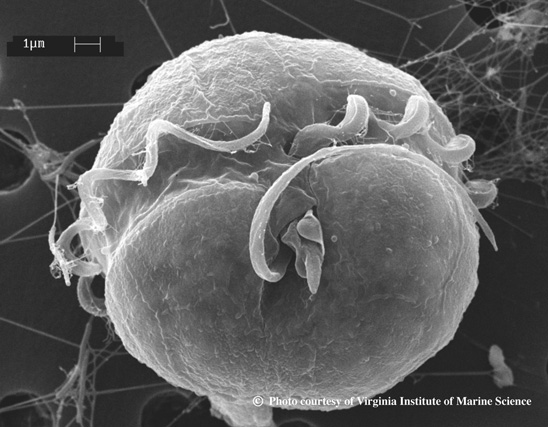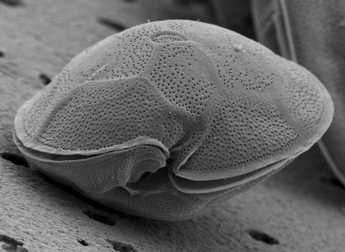Other HAB Species
Of some 60 or so species that cause red tides, only a handful is known to be toxic. Dominant dinoflagellate HAB genera include Alexandrium, Karenia, and Pfiesteria. The diatom genus most commonly associated with HABs is Pseudo-nitzschia. Each of these genera produces a different toxin and thus has a different role on organisms further up the food chain. Next, we discuss some of the HAB species in detail.

Alexandrium spp. is the dominant taxon in coastal regions of New England and eastern Canada but it is also found from California to Alaska.
It is a heterotrophic dinoflagellate that produces a saxitoxin, one of the most powerful known types of neurotoxins. These toxins destroy the function of nerve cells and can thereby cause paralysis. Saxitoxins are most effectively concentrated by shellfish such as clams, quahogs, mussels, scallops and oysters that filter large volumes of seawater to acquire their nutrition. Although the saxitoxin does not harm these shellfish, even in small quantities, the toxin can be extremely dangerous for humans, resulting in a serious illness known as paralytic shellfish poisoning (PSP). The saxitoxin attacks the human nervous system within 30 minutes of ingestion with symptoms that may include numbness, tingling, weakness, partial paralysis, incoherent speech, and nausea. In severe cases, the toxin can lead to respiratory failure and death within a few hours. Alexandrium spp. toxins have also been harmful to whales, sea otters and birds.
The following videos describe the causes and impacts of red tides, as well as possible antidotes for shellfish poisoning.
Video: Florida's toxic red tide is a perfect storm for the Gulf Coast (7:47)
PBS REPORTER: The growth of an algae, known as red tide, has exploded in Florida this year, growing bigger and lasting longer than years before. It has killed huge numbers of marine life and dealt a hard blow to the gulf coast economy. As William Brangham reports from Sanibel Island, there are many causes driving this red tide, including warmer waters tied to climate change. And there are other questions about what role humans are playing. It's part of our weekly series on the leading edge of science, technology, and medicine.
WILLIAM BRANGHAM: This is now a typical morning on Florida's gulf coast. Not a tourist in sight, just work crews cleaning up the daily toll of dead fish. They were killed by red tide, an almost annual bloom of algae in the Gulf of Mexico. At high levels, the algae release a neurotoxin that's deadly to marine life. It poisons them or makes it so they can't breathe. But this year's bloom, which actually began last fall, has been particularly bad.
FEMALE REPORTER: It now spreads across 130 miles of coast.
MALE REPORTER 1: Thousands of dead fish floating along Lido Beach.
MALE REPORTER 2: This red tide bloom is being called the worst in more than a decade.
BRANGHAM: In the last few months, red tide has killed dolphins, sea turtles, manatees, even a 26-foot whale shark.
DR. HEATHER BARRON, VETERINARIAN, CLINIC FOR THE REHABILITATION OF WILDLIFE: It's definitely some deformities here.....
WILLIAM BRANGHAM: Veterinarian Dr. Heather Barron runs the Clinic for the Rehabilitation of Wildlife on Sanibel Island. These baby loggerhead turtles just came in. Barron suspects that they or their mom was poisoned by the red tide.
DR. BARRON: There's probably not a whole lot we're going to be able to do for them.
WILLIAM BRANGHAM: She says they've seen four times the number of sea turtles poisoned by red tide this year.
DR. BARRON: It is overwhelming and catastrophic the number of patients that are coming in. We've had as many 100 patients come in in two days, all affected with red tide, way out of the ordinary. And so, when that happens, one of the things that you sometimes have to do is to be able to triage those animals and decide who are you likely to be able to save, who needs help the most, and who are you probably not going to save regardless.
WILLIAM BRANGHAM: This pelican came in near-death several weeks ago. But after intensive treatment, he seems to be turning the corner. So too are these sea turtles.
DR. BARRON: I think, even if you're not a bunny hugger like I am, you know, even if you don't care about the wildlife, you should care about what that means for your health and your children's health, and your pet's health, and your food supply's health, it's not going to be just wildlife that' going to be affected by this.
WILLIAM BRANGHAM: While the red tide is obviously devastating to wildlife, it's also difficult for humans as well. The toxins emit a terrible smell, they burn your eyes, they burn your throat, and as you can see, nobody is on these beaches. This year's red tide has been brutal to tourism, blanketing more than 100 miles of southwest Florida. Here on Sanibel Island, the Chamber of Commerce estimates eleven million dollars in lost income in just the first half of August.
TRASI SHARP, OVER EASY CAFE: We're probably off about another 45-50 percent of what we usually do this time of year. Thank you guys for coming in.
WILLIAM BRANGHAM:Traci Sharp owns and runs the Over Easy Cafe. I's a small breakfast and lunch spot in Sanibel, just a few blocks off the beach. But, it's scary.
TRASI SHARP: Well, somehow we'll get through this. We're hoping it doesn't last at this pace for too long.
BEN BURY: You couldn't drive 100 years without passing a thousand or ten thousand dead fish.
WILLIAM BRANGHAM: Ben Bury is a charter boat captain on Sanibel. He makes his living taking tourists out to fish, and picnic, and swim - things that many people just don't want to do right now.
BEN BURY: I know as a captain, my business for the month of August, was down somewhere around 80 percent.
WILLIAM BRANGHAM: 80 percent?
BEN BURY: Yeah. I don't think there' anyone that's in the tourism business in our area right now, or in any business that's on the water, that isn't really suffering right now.
DR. RICK BARTLESON, ECOLOGIST, SANIBEL CAPTIVA CONSERVATION FOUNDATION: This is an optical oxygen sensor.
WILLIAM BRANGHAM: In fact, things have been so slow for Bury, that he's volunteered his boat to scientists who are studying the red tide, like his friend Dr. Rick Bartleson. Bartleson's an ecologist with the Sanibel Captiva Conservation Foundation. He's checking the water at various spots, measuring the concentration of red tide cells. He says with a usual red tide, one that will kill some fish, you'd see a hundred to two hundred thousand red tide cells per liter of water. But this year, the red tide has been ten times worse.
DR. BARTLESON: Instead of 200 thousand, we're seeing 2 million or 20 million cells per liter.
WILLIAM BRANGHAM: I mean, that's a huge jump up.
DR. BARTLESON: Right, the other day we saw 40 million cells per liter about a kilometer off the coast.
WILLIAM BRANGHAM: While the red tide has been disastrous for the gulf, this summer it's been compounded by a bloom of blue-green algae in Florida's freshwaters. It's created a perfect storm for fish, wildlife, and humans, and it's leading some to wonder if one is exacerbating the other.
STEVE DAVIS, THE EVERGLADES FOUNDATION: You can see the green algae, here, on the Cape Coral side.....
WILLIAM BRANGHAM: The Everglades Foundation's Steve Davis took us along the Caloosahatchee River about 70 miles east, to show us one source of the problem. For thousands of years in Florida, water flowed down into Lake Okeechobee where it flooded out and south through Florida's everglade marshes. But as farming expanded around the lake, Lake Okeechobee was damned up, forcing that water to the east and to the west.
STEVE DAVIS: The massive volumes of freshwater that are released from the lake to the Caloosahatchee, they result in harm.
WILLIAM BRANGHAM: Davis says this causes two problems. One, that freshwater kills crucial habitat that needs saltier water, and two, that water is so polluted with runoff from farms and towns that it could be delivering a huge nutrient-boost to the red tide.
STEVE DAVIS: When you think about red tide, it's really another bloom of algae, but offshore. And these blooms of algae, they require large loads of nutrients in order to sustain themselves. It's kind of like thinking of a wildfire that requires fuel in order for it to continue burning.
WILLIAM BRANGHAM: Davis and others argue water needs to again flow south, like it once did, to address both the green-blue algae and any potential impact on red tide. But the powerful agricultural industry in Florida, has successfully stymied these efforts before.
AD ON THE TV: It's killing sealife, battering our economy, and making people sick, and it's fair to blame Rick Scott.
WILLIAM BRANGHAM: And now, ahead of the mid-term elections, water quality is a central issue.
TRAS SHARP: We need the state and federal help. There's industry and farming that dumps into the water, s of Okachobee, but also it's on everyone - fertilizers in people's yards, the dumping of waste of various companies along the river. We just need to do something, or this is going to last generations.
BEN BURY: That's all I care about this election, is I want people that are going to get out there and do something and make things better, that are gonna make it possible for me to continue to do what I love for a living.
WILLIAM BRANGHAM: A strong storm or cold front could break up this current red tide, and Tropical Storm Gordon, which just passed over Florida, may have done just that. But it's just a few months until the next potential bloom reemerges from the Gulf. For the PBS News Hour, I'm William Brangham, Sanibel, Florida.
FEMALE REPORTER: Such important reporting. Thank you, William.
Video: Prized Science Episode 4: Taming the Red Tides (4:28)
[MUSIC PLAYING]
PERSON QUOTING BIBLICAL SCRIPTURE: "And all the waters that were in the river were turned to blood, and the fish that was in the river died and the river stank. And the Egyptians could not drink of the water of the river."
NARRATOR: The Book of Exodus in the Holy Bible may give us the first account of a red tide. Red tides are a phenomenon in which certain pigmented algae, toxic algae, undergo population explosions. They bloom in enormous numbers, staining the water reddish brown. Toxins or poisons released by the algae periodically kill millions of fish and cause billions of dollars in losses to the global commercial fishing industry.
If health officials detect a red tide, they ban fishing for oysters, shrimp, and other shellfish. If they didn't, unsuspecting consumers would get hit with a virtual tidal wave of discomfort in the form of neurotoxic shellfish poisoning. This terrible form of food poisoning causes noxious nausea and vomiting, but tingling of the mouth, arms, and legs, as well as poor coordination and other very unpleasant symptoms. With no specific treatment, victims may suffer for days on end.
That may change thanks to the research of Michael Crimmins, a scientist at the University of North Carolina in Chapel Hill. His work focuses on brevetoxin A, the compound that causes neurotoxic shellfish poisoning. It could even lead to the world's first antidote for this painful condition. For that research, the American Chemical Society awarded Crimmins its 2010 Ernest Guenther award in the chemistry of natural products.
Natural products are chemical compounds produced by plants, animals, and other living things. Natural products or substances derived from them have been the source of almost one out of every three of our prescription drugs. For more, here's Dr. Crimmins.
MICHAEL CRIMMINS: So brevetoxin A is a very complex structure that was isolated from red algae. And this red algae, the scientific name is karenia brevis. It creates these massive algae blooms in the Gulf of Mexico and the Pacific in various places. And these massive growths of algae create what is called red tides. And these red tides are these red algae that have grown sort of out-of-control over miles and miles and miles of ocean. They can be 50, 100 miles wide or long. And these algae produce a series of neurotoxic compounds, of which brevetoxin A is one of those compounds.
NARRATOR: When shellfish encounter algae in these red tides, they take up the toxins. People who eat contaminated shellfish then become ill. The algae can also produce a toxic mist which is swept along by the wind, like fog. People along the beach or in ships can become sick simply by inhaling this contaminated sea mist. In their quest to develop medicines to treat neurotoxic shellfish poisoning, Crimmins and his colleagues have been gathering knowledge about brevetoxin A and related toxins.
MICHAEL CRIMMINS: What we've been trying to do is to develop a synthesis of these compounds in the laboratory. While they're incredibly toxic, they're not really available in very large quantities from the natural sources. So we've been trying to develop a chemical synthesis of the compounds in an effort to perhaps develop analogs that would be effective antidotes to these compounds.
NARRATOR: Dr. Crimmins is talking about a potential cure for neurotoxic shellfish poisoning. For those who might encounter the toxin, that could reduce an ancient health threat of biblical proportions to a mere ripple.
Karenia is the dominant taxon causing red tides in Florida and Texas, but rarely species of Karenia have also been found up the east coast in North Carolina.
Examples of Karenia
It produces a toxin known as a brevetoxin (named after a species of Karenia, K. brevis). Like saxitoxins, brevetoxins damage nerve cells, leading to disruption of normal neurological processes and causing neurotoxic shellfish poisoning (NSP). In humans, gastrointestinal symptoms and a variety of neurological ailments result, but there are no known fatalities. However, in fish, the brevetoxins attack the central nervous system and cause respiratory failure. Karenia dinoflagellates are responsible for massive fish and bird kills in the Gulf of Mexico. The brevetoxins are colorless, odorless, and heat and acid stable, thus they survive food preparation.
The genus Gambierdiscus lives in tropical waters, usually in reefs, and produces a toxin known as Ciguatoxin that causes gastrointestinal problems followed by mild neurological symptoms. This syndrome is known as Ciguatera fish poisoning. Because the toxin is fat soluble, it gets concentrated up the food chain by bioaccumulation from seaweed to smaller fish than to larger fish. The larger fish, which are the most dangerous to eat because they have the highest toxin concentrations, include commercially available seafood such as grouper, snapper, and barracuda. Ciguatera is responsible for more human illnesses—estimated between 10,000 to 50,000 cases annually—than any other HAB toxin.

Pseudo-nitzschia and the species Nitzschia navis-varingica are common diatom genera in Californian red tides. These taxa produce domoic acid, which is concentrated by filter-feeding shellfish. This neurotoxin can also bioaccumulate in fish such as anchovies that feed directly on the diatoms. Domoic acid causes a variety of gastrointestinal ailments, memory loss and brain damage in humans and is hence referred to as amnesic shellfish poisoning. Rarely, the neurotoxin can be fatal. It can also affect marine mammals, causing seizures.

The species Pfiesteria piscicida and P. shumwayae have been the most common dinoflagellate species in red tides in estuaries and bays along the east coast of the US from Delaware to Florida. The species occur in environments where freshwater and saltwater mix and have not been reported from freshwater environments or the open ocean. Pfiesteria blooms are restricted to summer months. Species have been associated with massive kills of menhaden and other estuarine fish in the Chesapeake Bay and the Tar-Pamlico and Neuse River Estuaries in North Carolina. The fish in contact with Pfiesteria rapidly develop bleeding lesions and have skin actively flake off them, and it has been proposed that the presence of live fish stimulates the production of toxin in the dinoflagellate. Ultimately the open lesions may destroy gill function and lead to death. Nevertheless, the connection between fish mortality and Pfiesteria is still doubted by some scientists. In fact, the effects of Pfiesteria on fish and human health has been one of the largest and nastiest controversies in marine science over the last 25 years and it does not appear that the conflict is anywhere near over.
The following video explains some of the research on Pfiesteria.
Video: Pfiesteria Update: An Enduring Debate (4:57)
NARRATOR: In the spring of 1997, sick fish began showing up in the pound nets of watermen working along the Pocomoke River.
And soon after, some of those same watermen began showing up in doctors' offices. In these pound nets, floating among the sick fish, was a microbe called Pfiesteria piscicida, first identified in the wild by a North Carolina scientist named JoAnn Burkholder. She claimed this one-celled organism could sometimes release a toxin in the presence of fish, and that toxin could make people sick. Pfiesteria could also change shape, shifting through 24 life cycle stages from tiny zoospores all the way to large amoeba forms.
The search for more answers about this new organism has led to conflicting, even contradictory findings, kicking off complicated debates among marine scientists. When Wayne Litaker investigated Pfiesteria, he found a very simple life cycle with no amoeba forms at all. He used sophisticated molecular RNA probes as well as computer-controlled photography.
DR. WAYNE LITAKER, NOAA BEAUFORT LABORATORY: So, you actually have the computer turn the microscope on every so often, turn the lights on, and take a picture, turn it off, and then you put it all together in a movie. And you can actually follow what's happening through time. We never saw any transformations. We saw a normal seven stage dinoflagellate life cycle. So, we didn't see any of those transformations whatsoever.
NARRATOR: Other researchers contradicted Burkholder's claim that Pfiesteria used a toxin to kill fish. At the Virginia Institute of Marine Science, Wolfgang Vogelbein announced evidence that Pfiesteria kills fish by directly feeding on them, not by releasing a toxin.
WOLFGANG VOGELBEIN: OK, what you're seeing here is the tail fin of an anesthetized fish. These fish and these dinoflagellates are directly attacking the fish and feeding on the skin. It's that simple.
NARRATOR: Vogelbein put a filter between his hungry Pfiesteria and his tiny test fish, a filter that would keep any Pfiesteria out, but let any toxin pass through. A simple experiment with repeatable results. None of his fish died.
WOLFGANG VOGELBEIN: We can actually see what's happening, and we're finding out that there isn't an exotoxin here, at least not in our cultures.
NARRATOR: Fish were not dying from Pfiesteria toxin, but from Pfiesteria feeding.
WOLFGANG VOGELBEIN: This happens. You've seen it today, we've shown it to you. Firsthand. You've seen it. It happens. This is how fish die in our cultures.
Others say toxins kill their fish. Fine, let's do a comparative study, let's get to the bottom of it.
JOANN BURKHOLDER: Toxic Pfiesteria is not on trial here. Toxic Pfiesteria exists. There is no question. It's been cross confirmed in multiple laboratories.
NARRATOR: Andrew Gordon runs one of the laboratories where a Pfiesteria connected toxin is killing fish. His technique runs water from a toxic culture through a filter removing all the Pfiesteria cells, then tests this filter in Pfiesteria-free water on small fish.
ANDREW GORDON: I have no doubt that in these systems in the presence of Pfiesteria, that there is a soluble toxin produced. And we've seen it. I've had undergraduates do the experiment; they're seeing it; they're all over the country now. And they're believers because they've done the experiment themselves. It's a very simple experiment to do.
NARRATOR: A simple experiment with repeatable results. In most of his experiments, all of his fish died.
ANDREW GORDON: The toxin that's produced is Pfiesteria-associated. You never see it in the absence of Pfiesteria, and you see it in the presence of Pfiesteria. So, that's pretty clear.
NARRATOR: What is not so clear so far from all the studies in the laboratory is how much harm these toxins can cause in our rivers, either to fish or to people.
JOANN BURKHOLDER: We have a long ways to go, and we just don't understand what turns on and off toxin production in these creatures. I wouldn't be surprised if the so-called nontoxic or non-inducible strains of Pfiesteria make toxin. But just can't somehow turn it on or activate it. And we'll be finding that out, I think, in the next couple of years.
NARRATOR: By the time Pfiesteria blooms again in the Chesapeake, scientists may have more answers to some of these contentious questions.
At least part of the debate has been fueled by the popular press, who have focused attention on the organism after studies suggested that it was carnivorous. These studies indicated that Pfiesteria species ingested the skin of fish after it flaked off. In fact, lab studies have shown that when fish were left in tanks with Pfiesteria, the fish died within hours. For this to occur, however, the dinoflagellate and fish must be in direct contact. Without contact, the same studies show that fish suffered no ill effects. Some scientists alternatively point to water molds or fungi including the species Aphanomyces invadans as the pathogen cause of the ulcerative lesions, skin loss, and damage to gills. A. invadans and other fungi are universally present in fish with ulcers and skin loss. Also weakening the case for Pfiesteria, this genus is still known to exist in North Carolina estuaries, but fish kills have become less frequent recently. Moreover, where lesions on the fish menhaden were observed, nearby fish including catfish, perch, and carp were unaffected. These disparities have cast some doubt on whether Pfiesteria is harmful to fish at all. In fact, great differences exist among public health professionals, and warnings from different state agencies are in conflict.
Examples of Pfiesteria
The health impact of Pfiesteria on humans is also uncertain, as is the method of transmission of the potential toxin. Scientists working with Pfiesteria in the laboratory have suffered from long-term neurological symptoms, such as memory loss, fatigue, and dermatological problems, and fisherman in contact with Pfiesteria-related fish kills have also suffered from similar ailments. However, other groups of fishermen who have come in close contact with lesion-covered fish have not reported adverse effects. There are reports that the hypothetical Pfiesteria toxin is transmitted via aerosols.
Until recently, the missing link in the Pfiesteria conundrum is that the toxin produced by this organism has been elusive. However, in 2007 scientists in a government lab claimed the first positive identification of a toxin associated with Pfiesteria. Even with this identification, questions remain; for one, the toxin is unstable in the natural environment, and second, it is not been proven to have adverse health effects. Thus, the controversy about Pfiesteria is far from over. In all reality, a number of factors may result in the fish kills; in particular, the fish in estuaries may have already been under great stress from other biological agents (bacteria, viruses, fungi, parasites), exposure to chemicals (pollutants, toxins), suboptimal water quality, and rapid water temperature change, that have the potential to cause lesions to form.
Far less controversial than the relationship of Pfiesteria with fish kills are studies that directly relate fish kills to low oxygen levels caused by algal blooms. In a number of estuaries along the eastern US, warmer waters in summer combined with increased production by algae, as a result of increased runoff and eutrophication, lead to severely decreased oxygen levels and major fish kills without the involvement of a toxin.

